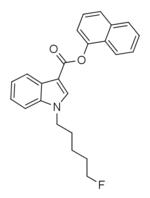NM-2201
NM-2201 (also known as CBL-2201) is an indole-based synthetic cannabinoid that presumably has similar properties to the closely related 5F-PB-22 and NNE1, which are both full agonists and unselectively bind to CB1 and CB2 receptors with low nanomolar affinity.[1][2][3][4]
 | |
| Legal status | |
|---|---|
| Legal status |
|
| Identifiers | |
| |
| CAS Number | |
| PubChem CID | |
| ChemSpider | |
| UNII | |
| CompTox Dashboard (EPA) | |
| Chemical and physical data | |
| Formula | C24H22FNO2 |
| Molar mass | 375.443 g·mol−1 |
| 3D model (JSmol) | |
| |
| |
Pharmacology
NM-2201 acts as a full agonist with a binding affinity of 0.332 nM at CB1 and 0.732 nM at CB2 cannabinoid receptors.[5] It has been linked to serious adverse events in users.[6]
Legal status
NM-2201 is specifically banned in Sweden,[7] Germany (Anlage II),[8] and Japan[9] but is also controlled in many other jurisdictions under analogue laws.
On May 30, 2018 the United States Drug Enforcement Administration, Department of Justice published a notice of intent to place NM-2201 and 4 other synthetic cannabinoids in schedule I of the Controlled Substances Act. This notice went into effect on June 29, 2018.[10]
Use
NM-2201 was linked to an incident in December 2015 where 25-30 people in Ocala, FL were taken to hospitals after experiencing seizures.[10]
References
- Kondrasenko AA, Goncharov EV, Dugaev KP, Rubaylo AI (December 2015). "CBL-2201. Report on a new designer drug: Napht-1-yl 1-(5-fluoropentyl)-1H-indole-3-carboxylate". Forensic Science International. 257: 209–213. doi:10.1016/j.forsciint.2015.08.023. PMID 26386336.
- "NM-2201". Cayman Chemical. Retrieved 9 July 2015.
- Namera A, Kawamura M, Nakamoto A, Saito T, Nagao M (2015). "Comprehensive review of the detection methods for synthetic cannabinoids and cathinones". Forensic Toxicology. 33 (2): 175–194. doi:10.1007/s11419-015-0270-0. PMC 4525208. PMID 26257831.
- Shevyrin V, Melkozerov V, Nevero A, Eltsov O, Baranovsky A, Shafran Y (November 2014). "Synthetic cannabinoids as designer drugs: new representatives of indol-3-carboxylates series and indazole-3-carboxylates as novel group of cannabinoids. Identification and analytical data". Forensic Science International. 244: 263–75. doi:10.1016/j.forsciint.2014.09.013. PMID 25305529.
- Hess C, Schoeder CT, Pillaiyar T, Madea B, Müller CE (2016). "Pharmacological evaluation of synthetic cannabinoids identified as constituents of spice". Forensic Toxicology. 34 (2): 329–343. doi:10.1007/s11419-016-0320-2. PMC 4929166. PMID 27429655.
- Samra K, Boon IS, Packer G, Jacob S (April 2017). "black mamba". BMJ Case Reports. 2017: bcr–2016–218431. doi:10.1136/bcr-2016-218431. PMC 5534782. PMID 28433979.
- "Cannabinoider föreslås bli klassade som hälsofarlig vara" (in Swedish). Folkhälsomyndigheten. Retrieved 9 July 2015.
- "Gesetz über den Verkehr mit Betäubungsmitteln Anlage II". www.gesetze-im-internet.de (in German). Bundesministerium der Justiz und für Verbraucherschutz. Retrieved 24 October 2016.
- Diao X, Carlier J, Zhu M, Pang S, Kronstrand R, Scheidweiler KB, Huestis MA (January 2017). "In vitro and in vivo human metabolism of a new synthetic cannabinoid NM-2201 (CBL-2201)". Forensic Toxicology. 35 (1): 20–32. doi:10.1007/s11419-016-0326-9. PMC 5342258. PMID 28286577.
- "2018 - Temporary Placement of NM2201, 5F-AB-PINACA, 4-CN-CUMYL-BUTINACA, MMB-CHMICA and 5F-CUMYL-P7AICA Into Schedule I". www.deadiversion.usdoj.gov. Retrieved 2018-06-15.